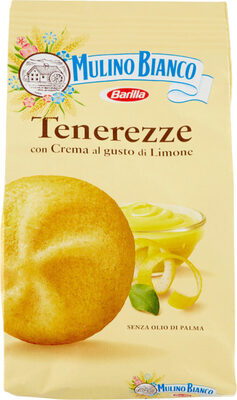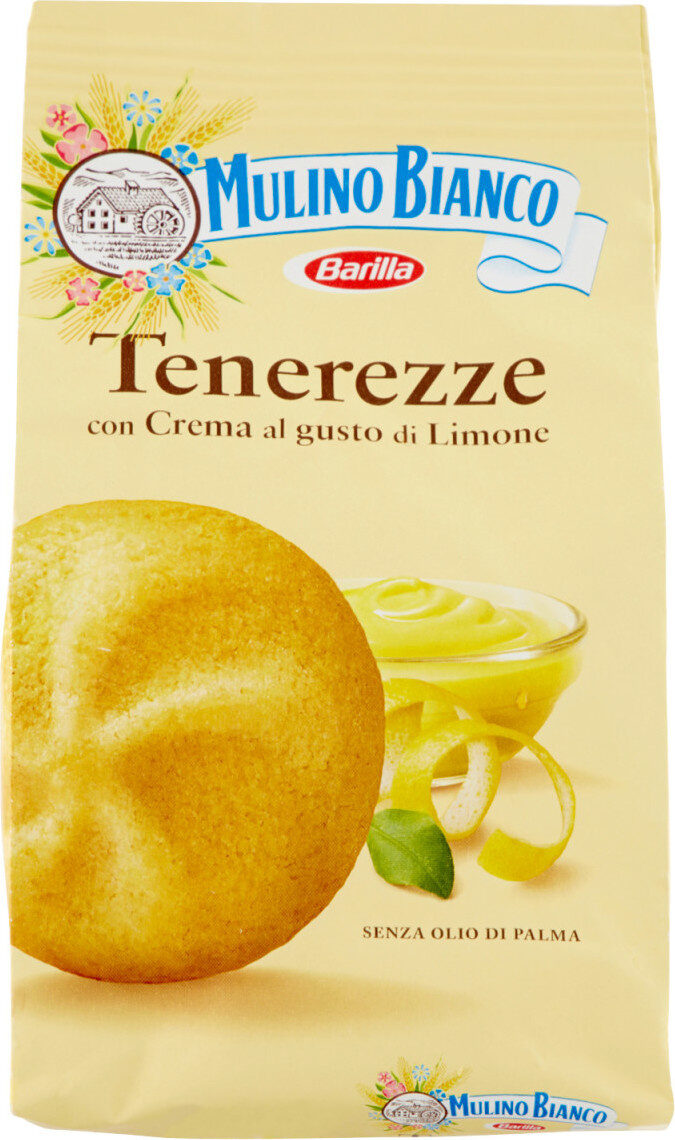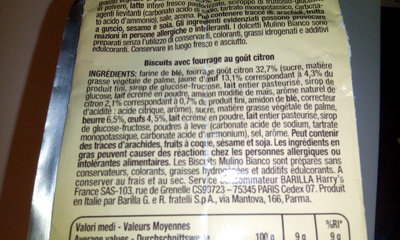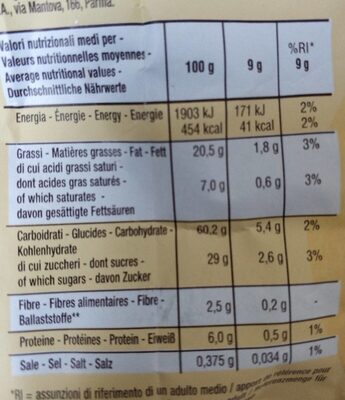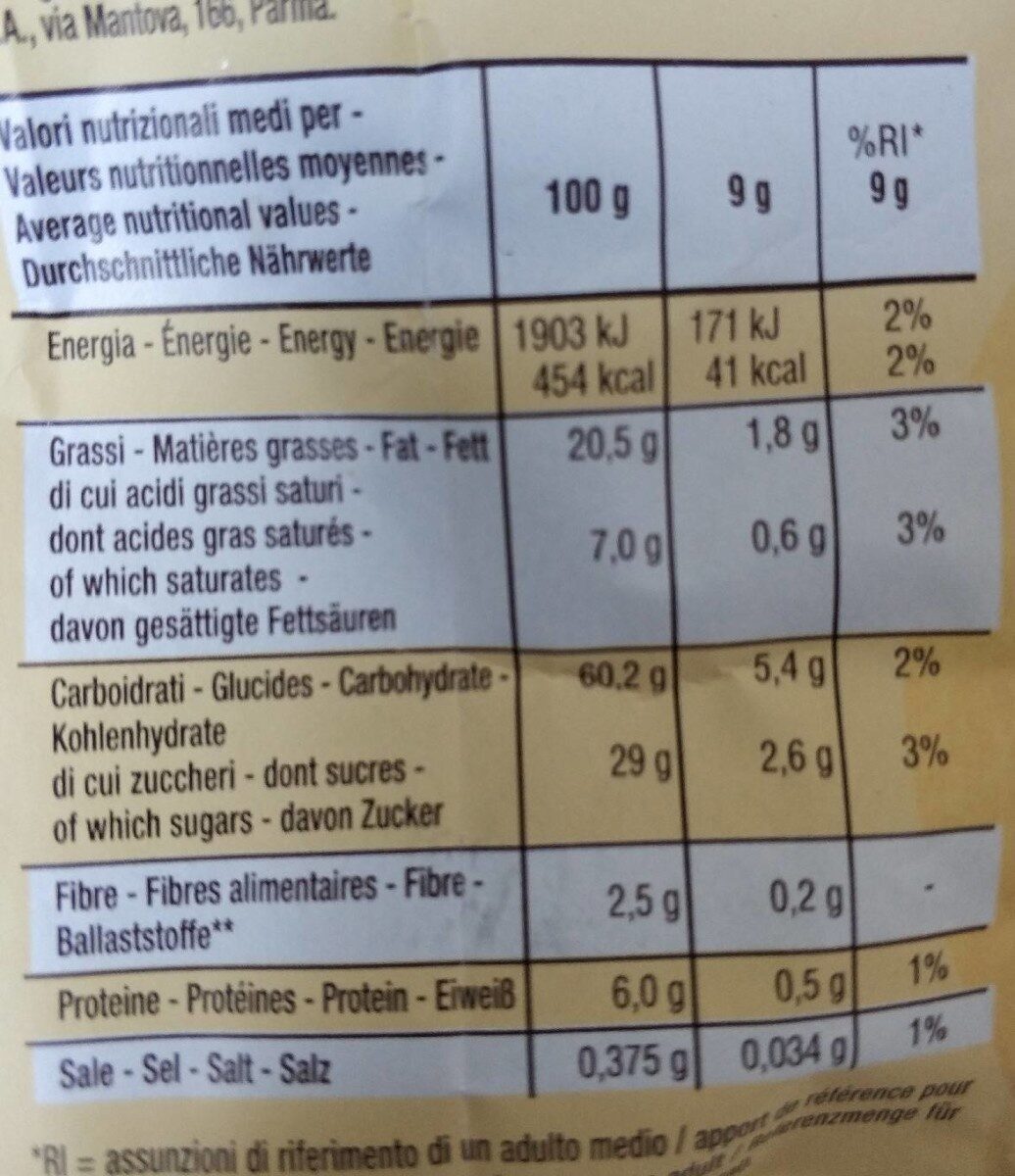Help us make food transparency the norm!
As a non-profit organization, we depend on your donations to continue informing consumers around the world about what they eat.
The food revolution starts with you!
Tenerezze con crema al gusto di limone - Mulino Bianco - 200 g
Tenerezze con crema al gusto di limone - Mulino Bianco - 200 g
This product page is not complete. You can help to complete it by editing it and adding more data from the photos we have, or by taking more photos using the app for Android or iPhone/iPad. Thank you!
×
Barcode: 8076809529969 (EAN / EAN-13)
Common name: Biscuit avec fourrage au goût citron
Quantity: 200 g
Packaging: Sachet
Brands: Mulino Bianco
Categories: Snacks, Sweet snacks, Biscuits and cakes, Biscuits
Stores: Intermarché
Countries where sold: France
Matching with your preferences
Health
Ingredients
-
28 ingredients
French: farine de blé, fourrage goût citron 32.7%(sucre, matière grasse végétale de palme, jaune d'oeuf 13.1% correspondant à 4.3% du produit fini, sirop de glucose-fructose, lait entier pasteurisé, sirop de glucose, lait écrémé en poudre, amidon modifié de maïs, arôme naturel de citron 2.1% correspondant à 0.7% du produit fini, amidon de blé,correcteur d'acidité : acide citrique, arôme), sucre, matière grasse végétale de palme, beurre 6.5%, oeufs 4.5% , lait écrémé en poudre, lait entier pasteurisé, sirop de glucose-fructose, poudre à lever (carbonate acide de sodium, tartrate monopotassique, carbonate acide d'ammonium, sel, arôme.Allergens: Eggs, Gluten, MilkTraces: En-gluten-en-nuts-en-peanuts-en-sesame-seeds-en-soybeans
Food processing
-
Ultra processed foods
Elements that indicate the product is in the 4 - Ultra processed food and drink products group:
- Additive: E14XX - Modified Starch
- Ingredient: Flavouring
- Ingredient: Glucose
- Ingredient: Glucose syrup
Food products are classified into 4 groups according to their degree of processing:
- Unprocessed or minimally processed foods
- Processed culinary ingredients
- Processed foods
- Ultra processed foods
The determination of the group is based on the category of the product and on the ingredients it contains.
Additives
-
E330 - Citric acid
Citric acid is a natural organic acid found in citrus fruits such as lemons, oranges, and limes.
It is widely used in the food industry as a flavor enhancer, acidulant, and preservative due to its tart and refreshing taste.
Citric acid is safe for consumption when used in moderation and is considered a generally recognized as safe (GRAS) food additive by regulatory agencies worldwide.
-
E336 - Potassium tartrates
Potassium tartrate: Potassium tartrate, dipotassium tartrate or argol has formula K2C4H4O6. It is the potassium salt of tartaric acid. It is often confused with potassium bitartrate, also known as cream of tartar. As a food additive, it shares the E number E336 with potassium bitartrate.Source: Wikipedia
-
E336i - Monopotassium tartrate
Potassium tartrate: Potassium tartrate, dipotassium tartrate or argol has formula K2C4H4O6. It is the potassium salt of tartaric acid. It is often confused with potassium bitartrate, also known as cream of tartar. As a food additive, it shares the E number E336 with potassium bitartrate.Source: Wikipedia
-
E500 - Sodium carbonates
Sodium carbonates (E500) are compounds commonly used in food preparation as leavening agents, helping baked goods rise by releasing carbon dioxide when they interact with acids.
Often found in baking soda, they regulate the pH of food, preventing it from becoming too acidic or too alkaline. In the culinary world, sodium carbonates can also enhance the texture and structure of foods, such as noodles, by modifying the gluten network.
Generally recognized as safe, sodium carbonates are non-toxic when consumed in typical amounts found in food.
-
E500ii - Sodium hydrogen carbonate
Sodium hydrogen carbonate, also known as E500ii, is a food additive commonly used as a leavening agent.
When added to recipes, it releases carbon dioxide gas upon exposure to heat or acids, causing dough to rise and resulting in a light, fluffy texture in baked goods.
It is generally recognized as safe (GRAS) by regulatory authorities when used in appropriate quantities and poses no significant health risks when consumed in typical food applications.
-
E503 - Ammonium carbonates
Ammonium carbonate: Ammonium carbonate is a salt with the chemical formula -NH4-2CO3. Since it readily degrades to gaseous ammonia and carbon dioxide upon heating, it is used as a leavening agent and also as smelling salt. It is also known as baker's ammonia and was a predecessor to the more modern leavening agents baking soda and baking powder. It is a component of what was formerly known as sal volatile and salt of hartshorn.Source: Wikipedia
-
E503ii - Ammonium hydrogen carbonate
Ammonium carbonate: Ammonium carbonate is a salt with the chemical formula -NH4-2CO3. Since it readily degrades to gaseous ammonia and carbon dioxide upon heating, it is used as a leavening agent and also as smelling salt. It is also known as baker's ammonia and was a predecessor to the more modern leavening agents baking soda and baking powder. It is a component of what was formerly known as sal volatile and salt of hartshorn.Source: Wikipedia
Ingredients analysis
-
Palm oil
Ingredients that contain palm oil: Palm fat, Palm fat
-
Non-vegan
Non-vegan ingredients: Pasteurised whole milk, Skimmed milk powder, Butter, Egg, Skimmed milk powder, Pasteurised whole milkSome ingredients could not be recognized.
We need your help!
You can help us recognize more ingredients and better analyze the list of ingredients for this product and others:
- Edit this product page to correct spelling mistakes in the ingredients list, and/or to remove ingredients in other languages and sentences that are not related to the ingredients.
- Add new entries, synonyms or translations to our multilingual lists of ingredients, ingredient processing methods, and labels.
If you would like to help, join the #ingredients channel on our Slack discussion space and/or learn about ingredients analysis on our wiki. Thank you!
-
Vegetarian status unknown
Unrecognized ingredients: fr:fourrage-gout-citron, fr:jaune-d-oeuf-13-1-correspondant-a-4-3-du-produit-fini, fr:arome-naturel-de-citron-2-1-correspondant-a-0-7-du-produit-finiSome ingredients could not be recognized.
We need your help!
You can help us recognize more ingredients and better analyze the list of ingredients for this product and others:
- Edit this product page to correct spelling mistakes in the ingredients list, and/or to remove ingredients in other languages and sentences that are not related to the ingredients.
- Add new entries, synonyms or translations to our multilingual lists of ingredients, ingredient processing methods, and labels.
If you would like to help, join the #ingredients channel on our Slack discussion space and/or learn about ingredients analysis on our wiki. Thank you!
-
Details of the analysis of the ingredients
We need your help!
Some ingredients could not be recognized.
We need your help!
You can help us recognize more ingredients and better analyze the list of ingredients for this product and others:
- Edit this product page to correct spelling mistakes in the ingredients list, and/or to remove ingredients in other languages and sentences that are not related to the ingredients.
- Add new entries, synonyms or translations to our multilingual lists of ingredients, ingredient processing methods, and labels.
If you would like to help, join the #ingredients channel on our Slack discussion space and/or learn about ingredients analysis on our wiki. Thank you!
fr: farine de blé, fourrage goût citron 32.7% (sucre, matière grasse végétale de palme, jaune d'oeuf 13.1% correspondant à 4.3% du produit fini, sirop de glucose-fructose, lait entier pasteurisé, sirop de glucose, lait écrémé en poudre, amidon modifié de maïs, arôme naturel de citron 2.1% correspondant à 0.7% du produit fini, amidon de blé, correcteur d'acidité (acide citrique), arôme), sucre, matière grasse végétale de palme, beurre 6.5%, oeufs 4.5%, lait écrémé en poudre, lait entier pasteurisé, sirop de glucose-fructose, poudre à lever, carbonate acide de sodium, tartrate monopotassique, carbonate acide d'ammonium, sel, arôme- farine de blé -> en:wheat-flour - vegan: yes - vegetarian: yes - ciqual_proxy_food_code: 9410 - percent_min: 32.7 - percent_max: 43.3
- fourrage goût citron -> fr:fourrage-gout-citron - percent_min: 32.7 - percent: 32.7 - percent_max: 32.7
- sucre -> en:sugar - vegan: yes - vegetarian: yes - ciqual_proxy_food_code: 31016 - percent_min: 2.725 - percent_max: 29
- matière grasse végétale de palme -> en:palm-fat - vegan: yes - vegetarian: yes - from_palm_oil: yes - ciqual_proxy_food_code: 16129 - percent_min: 0.336363636363637 - percent_max: 16.35
- jaune d'oeuf 13.1% correspondant à 4.3% du produit fini -> fr:jaune-d-oeuf-13-1-correspondant-a-4-3-du-produit-fini - percent_min: 0 - percent_max: 10.9
- sirop de glucose-fructose -> en:glucose-fructose-syrup - vegan: yes - vegetarian: yes - ciqual_food_code: 31077 - percent_min: 0 - percent_max: 8.175
- lait entier pasteurisé -> en:pasteurised-whole-milk - vegan: no - vegetarian: yes - ciqual_food_code: 19024 - percent_min: 0 - percent_max: 6.54
- sirop de glucose -> en:glucose-syrup - vegan: yes - vegetarian: yes - ciqual_proxy_food_code: 31016 - percent_min: 0 - percent_max: 5.45
- lait écrémé en poudre -> en:skimmed-milk-powder - vegan: no - vegetarian: yes - ciqual_food_code: 19054 - percent_min: 0 - percent_max: 4.67142857142857
- amidon modifié de maïs -> en:modified-corn-starch - vegan: yes - vegetarian: yes - ciqual_food_code: 9510 - percent_min: 0 - percent_max: 4.0875
- arôme naturel de citron 2.1% correspondant à 0.7% du produit fini -> fr:arome-naturel-de-citron-2-1-correspondant-a-0-7-du-produit-fini - percent_min: 0 - percent_max: 3.63333333333333
- amidon de blé -> en:wheat-starch - vegan: yes - vegetarian: yes - ciqual_proxy_food_code: 9510 - percent_min: 0 - percent_max: 3.27
- correcteur d'acidité -> en:acidity-regulator - percent_min: 0 - percent_max: 2.97272727272727
- acide citrique -> en:e330 - vegan: yes - vegetarian: yes - percent_min: 0 - percent_max: 2.97272727272727
- arôme -> en:flavouring - vegan: maybe - vegetarian: maybe - percent_min: 0 - percent_max: 2.725
- sucre -> en:sugar - vegan: yes - vegetarian: yes - ciqual_proxy_food_code: 31016 - percent_min: 6.5 - percent_max: 17.1
- matière grasse végétale de palme -> en:palm-fat - vegan: yes - vegetarian: yes - from_palm_oil: yes - ciqual_proxy_food_code: 16129 - percent_min: 6.5 - percent_max: 17.1
- beurre -> en:butter - vegan: no - vegetarian: yes - ciqual_proxy_food_code: 16400 - percent_min: 6.5 - percent: 6.5 - percent_max: 6.5
- oeufs -> en:egg - vegan: no - vegetarian: yes - ciqual_food_code: 22000 - percent_min: 4.5 - percent: 4.5 - percent_max: 4.5
- lait écrémé en poudre -> en:skimmed-milk-powder - vegan: no - vegetarian: yes - ciqual_food_code: 19054 - percent_min: 0 - percent_max: 3.42
- lait entier pasteurisé -> en:pasteurised-whole-milk - vegan: no - vegetarian: yes - ciqual_food_code: 19024 - percent_min: 0 - percent_max: 2.85
- sirop de glucose-fructose -> en:glucose-fructose-syrup - vegan: yes - vegetarian: yes - ciqual_food_code: 31077 - percent_min: 0 - percent_max: 2.44285714285714
- poudre à lever -> en:raising-agent - percent_min: 0 - percent_max: 2.1375
- carbonate acide de sodium -> en:e500ii - vegan: yes - vegetarian: yes - percent_min: 0 - percent_max: 1.9
- tartrate monopotassique -> en:e336 - vegan: yes - vegetarian: yes - percent_min: 0 - percent_max: 1.71
- carbonate acide d'ammonium -> en:e503ii - vegan: yes - vegetarian: yes - percent_min: 0 - percent_max: 1.55454545454545
- sel -> en:salt - vegan: yes - vegetarian: yes - ciqual_food_code: 11058 - percent_min: 0 - percent_max: 0.375
- arôme -> en:flavouring - vegan: maybe - vegetarian: maybe - percent_min: 0 - percent_max: 0.375
Nutrition
-
Poor nutritional quality
⚠ ️Warning: the amount of fruits, vegetables and nuts is not specified on the label, it was estimated from the list of ingredients: 0This product is not considered a beverage for the calculation of the Nutri-Score.
Positive points: 2
- Proteins: 3 / 5 (value: 6, rounded value: 6)
- Fiber: 2 / 5 (value: 2.5, rounded value: 2.5)
- Fruits, vegetables, nuts, and colza/walnut/olive oils: 0 / 5 (value: 0, rounded value: 0)
Negative points: 18
- Energy: 5 / 10 (value: 1900, rounded value: 1900)
- Sugars: 6 / 10 (value: 29, rounded value: 29)
- Saturated fat: 6 / 10 (value: 7, rounded value: 7)
- Sodium: 1 / 10 (value: 150, rounded value: 150)
The points for proteins are not counted because the negative points are greater or equal to 11.
Nutritional score: (18 - 2)
Nutri-Score:
-
Nutrient levels
-
Fat in high quantity (20.5%)
What you need to know- A high consumption of fat, especially saturated fats, can raise cholesterol, which increases the risk of heart diseases.
Recommendation: Limit the consumption of fat and saturated fat- Choose products with lower fat and saturated fat content.
-
Saturated fat in high quantity (7%)
What you need to know- A high consumption of fat, especially saturated fats, can raise cholesterol, which increases the risk of heart diseases.
Recommendation: Limit the consumption of fat and saturated fat- Choose products with lower fat and saturated fat content.
-
Sugars in high quantity (29%)
What you need to know- A high consumption of sugar can cause weight gain and tooth decay. It also augments the risk of type 2 diabetes and cardio-vascular diseases.
Recommendation: Limit the consumption of sugar and sugary drinks- Sugary drinks (such as sodas, fruit beverages, and fruit juices and nectars) should be limited as much as possible (no more than 1 glass a day).
- Choose products with lower sugar content and reduce the consumption of products with added sugars.
-
Salt in moderate quantity (0.375%)
What you need to know- A high consumption of salt (or sodium) can cause raised blood pressure, which can increase the risk of heart disease and stroke.
- Many people who have high blood pressure do not know it, as there are often no symptoms.
- Most people consume too much salt (on average 9 to 12 grams per day), around twice the recommended maximum level of intake.
Recommendation: Limit the consumption of salt and salted food- Reduce the quantity of salt used when cooking, and don't salt again at the table.
- Limit the consumption of salty snacks and choose products with lower salt content.
-
-
Nutrition facts
Nutrition facts As sold
for 100 g / 100 mlAs sold
per serving (9g)Compared to: Biscuits Energy 1,900 kj
(454 kcal)171 kj
(40 kcal)-3% Fat 20.5 g 1.84 g +2% Saturated fat 7 g 0.63 g -23% Carbohydrates 60.2 g 5.42 g -6% Sugars 29 g 2.61 g - Fiber 2.5 g 0.225 g -13% Proteins 6 g 0.54 g -4% Salt 0.375 g 0.034 g -38% Fruits‚ vegetables‚ nuts and rapeseed‚ walnut and olive oils (estimate from ingredients list analysis) 0 % 0 %
Environment
-
Eco-Score C - Moderate environmental impact
⚠ ️Select a country in order to include the full impact of transportation.The Eco-Score is an experimental score that summarizes the environmental impacts of food products.→ The Eco-Score was initially developped for France and it is being extended to other European countries. The Eco-Score formula is subject to change as it is regularly improved to make it more precise and better suited to each country.Life cycle analysis
-
Average impact of products of the same category: B (Score: 69/100)
Category: Biscuit (cookie)
Category: Biscuit (cookie)
- PEF environmental score: 0.35 (the lower the score, the lower the impact)
- including impact on climate change: 2.88 kg CO2 eq/kg of product
Stage Impact Agriculture
80.5 %Processing
11.8 %Packaging
3.1 %Transportation
3.2 %Distribution
1.4 %Consumption
0.0 %
Bonuses and maluses
-
Missing origins of ingredients information
Malus: -5
⚠ ️ The origins of the ingredients of this product are not indicated.
If they are indicated on the packaging, you can modify the product sheet and add them.
If you are the manufacturer of this product, you can send us the information with our free platform for producers.
-
Ingredients that threatens species
Malus: -10
Contains palm oil
Tropical forests in Asia, Africa and Latin America are destroyed to create and expand oil palm tree plantations. The deforestation contributes to climate change, and it endangers species such as the orangutan, the pigmy elephant and the Sumatran rhino.
-
Packaging with a medium impact
Malus: -10
Shape Material Recycling Impact Bag Unknown High ⚠ ️ The information about the packaging of this product is not sufficiently precise (exact shapes and materials of all components of the packaging).⚠ ️ For a more precise calculation of the Eco-Score, you can modify the product page and add them.
If you are the manufacturer of this product, you can send us the information with our free platform for producers.
Eco-Score for this product
-
Impact for this product: C (Score: 44/100)
Product: Tenerezze con crema al gusto di limone - Mulino Bianco - 200 g
Life cycle analysis score: 69
Sum of bonuses and maluses: -25
Final score: 44/100
-
Carbon footprint
-
Equal to driving 1.5 km in a petrol car
288 g CO² per 100g of product
The carbon emission figure comes from ADEME's Agribalyse database, for the category: Biscuit (cookie) (Source: ADEME Agribalyse Database)
Stage Impact Agriculture
82.9 %Processing
7.9 %Packaging
3.8 %Transportation
4.7 %Distribution
0.7 %Consumption
0.0 %
Packaging
-
Packaging with a medium impact
-
Packaging parts
Bag
-
Packaging materials
Material % Packaging weight Packaging weight per 100 g of product
-
Transportation
-
Origins of ingredients
Missing origins of ingredients information
⚠ ️ The origins of the ingredients of this product are not indicated.
If they are indicated on the packaging, you can modify the product sheet and add them.
If you are the manufacturer of this product, you can send us the information with our free platform for producers.Add the origins of ingredients for this product Add the origins of ingredients for this product
Threatened species
-
Contains palm oil
Drives deforestation and threatens species such as the orangutan
Tropical forests in Asia, Africa and Latin America are destroyed to create and expand oil palm tree plantations. The deforestation contributes to climate change, and it endangers species such as the orangutan, the pigmy elephant and the Sumatran rhino.
Report a problem
-
Incomplete or incorrect information?
Category, labels, ingredients, allergens, nutritional information, photos etc.
If the information does not match the information on the packaging, please complete or correct it. Open Food Facts is a collaborative database, and every contribution is useful for all.
Data sources
Product added on by openfoodfacts-contributors
Last edit of product page on by guezguez-majed.
Product page also edited by ecoscore-impact-estimator, halal-app-chakib, kiliweb, oc84, packbot, quechoisir, telperion87, twoflower, yuka.BI1sOfWmEtA4GsfIyd8V9jWJTOK-CvhmGH4Tog, yuka.VElVYUNJc1pvcWtOdzhJNTRRLzc0L1l0bnBtMFlVVHBFOEFLSVE9PQ, yuka.WVlBTUU3OHJ1UElJdXZjRzB3SDIzT3d1MnJtSUFqTzFLOE5JSVE9PQ, yuka.WnJ0Y1M0b25vT0ZYb01JLzRoaUVxOXhUL3BXaVYyaThHcnN3SUE9PQ, yuka.sY2b0xO6T85zoF3NwEKvlk1kSufnvAzNFxnugWOU2tKDKMzXYopzuJfrAqs, yuka.sY2b0xO6T85zoF3NwEKvlkxZYYfzkyz5CiTgiU6z9s6JD8e2WsNT67fdCas.
